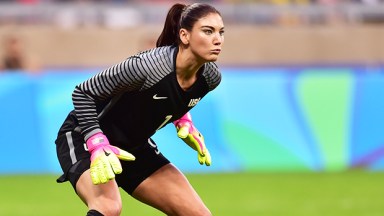
The United States Men’s National Team failed to qualify for the 2018 FIFA World Cup, missing the competition for the first time since 1986. While many have searched for an explanation behind this miserable failure, Hope Solo, 36, said the sport is too expensive for many non-white kids to play. “We have alienated the Hispanic communities. We have alienated our black communities. We have alienated the underrepresented communities, even rural communities,” Hope said while talking with Bonnie Bernstein at the Hashtag Sports conference on June 26, per Sporting News.
“So soccer in America right now is a rich white-kid sport,” the two-time Olympic gold medalist and World Cup champion added. “Then we have to ask ourselves, ‘Well, no wonder why we are not qualifying for the World Cup, when we have alienated a huge population of really talented youth soccer players.’ And that’s the state of the game right now.”
Hope is not the only one who has made this argument. “About 25 percent of American families have incomes over US $100,000 annually, yet they produce 35 percent of youth soccer players,” Rick Eckstein, a professor of Sociology at Villanova University, said when writing for The Conversation. “Conversely, the 25 percent of families with incomes below $25,000 account for only 13 percent of youth soccer players. Forty percent of youth soccer players will leave the sport between ages 13 and 18.
“Kids interested in playing soccer must increasingly pay for apparel, equipment, team fees, coaches, trainers, tournament travel and field space,” he added. “It’s not unusual for families to spend over $10,000 per child per year to play organized youth soccer.”
"Soccer in America right now is a rich white kid sport" @hopesolo #HS18 pic.twitter.com/mcgQh4n3x0
— Hashtag Sports (@HashtagSports) June 26, 2018
"My family would not have been able to afford to put me in soccer if I was a young kid today"
– @hopesolo #HS18 pic.twitter.com/vR6sV1qLDA— Hashtag Sports (@HashtagSports) June 26, 2018
In 2016, Roger Bennett of Men In Blazers and Greg Kaplan, an economics professor at the University of Chicago, compared the background of each of the US Men’s national team member from 1993 to 2013, according to The Guardian. They discovered that soccer players came from communities with higher incomes, education and employment rankings – and were white than the US average. While there were a lot of reasons for this, Briana Scurry, who won the World Cup in 1999 with the US women’s team, summed it up: “[Soccer in the US] continues to be seen as a white, suburban sport.”
The pay-to-play system in youth soccer – along with alienating poorer and talented players – has also been criticized in stripping the creativity from those who can afford the fees that cover the cost of equipment, coaches, fields, insurance and officials. “We are making these little robots,” Nick Lusson, a director of the NorCal Primier Soccer Foundation in 2016, told the Guardian, stressing that the over-coaching is squashing the creativity of players. So, when the soccer culture in America produces rich, white and sub-par players, no wonder the US doesn’t qualify for the World Cup.